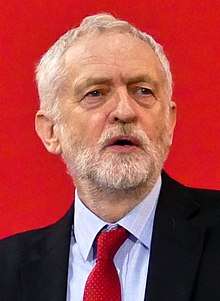Islington North (UK Parliament constituency)
Islington North (/ˈɪzlɪŋtən/) is a constituency created in 1885 represented in the House of Commons of the UK Parliament since 1983 by Jeremy Corbyn of the Labour Party, who served as Leader of the Labour Party and Leader of Her Majesty's Opposition from 2015 to 2020. The constituency covers the northern half of the London Borough of Islington. [n 1]
| Islington North | |
|---|---|
| Borough constituency for the House of Commons | |
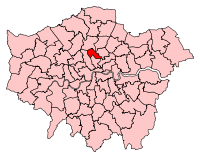 Boundary of Islington North in Greater London | |
| County | Greater London |
| Electorate | 75,162 (December 2019)[1] |
| Current constituency | |
| Created | 1885 |
| Member of Parliament | Jeremy Corbyn (Labour) |
| Number of members | One |
| Created from | Finsbury |
Political history
The constituency has elected a Labour Party candidate at each election since a by-election in 1937. Since then the smallest majority was 10.4% of the vote, in a by-election in 1969, on a very low turnout.
The MP since 1983, Jeremy Corbyn, had his smallest majority (15.3%) in 1983 and his largest (60.5%) in 2017. In the eight elections during Corbyn's tenure, the Conservatives have finished in second place four times while the Liberal Democrats have also been runners up on four occasions. The 2015 result made the seat the 26th safest of Labour's 232 seats by percentage of majority.[2]
In the 2016 referendum to leave the European Union, the constituency voted remain by 78.4%. This was the fifth highest support for remain for a constituency.[3]
Boundaries
1885–1918
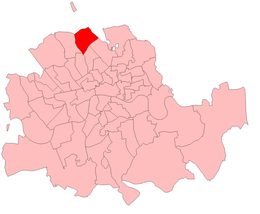
The seat was created by the Redistribution of Seats Act 1885, as one of four divisions of the new parliamentary borough of Islington. The constituency was defined in the legislation as consisting of the single ward of Upper Holloway of the parish of Islington. The ward was one of eight used in the election of Islington vestrymen under the Metropolis Management Act 1855.[4][5]
1918–1950
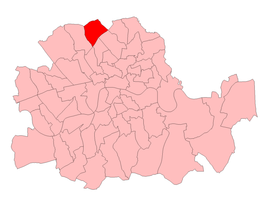
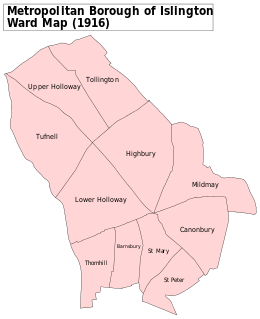
Under the next redistribution of seats by the Representation of the People Act 1918 constituencies in the County of London were defined in terms of wards of the metropolitan boroughs created in 1900. Islington North comprised three wards of the Metropolitan Borough of Islington: Tollington, Tufnell and Upper Holloway.[5][6]
1950–1974
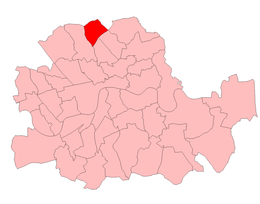
At the next redistribution of seats by the Representation of the People Act 1948 the constituency was again defined as Tollington, Tufnell and Upper Holloway wards of the Metropolitan Borough of Islington, with boundaries as they existed at the end of 1947.[5][7]
1974–1983
In 1965 local government in Greater London was reorganised, with the formation of London boroughs. The changes were reflected in parliamentary boundaries from 1974. The London Borough of Islington was divided into three constituencies. Islington North was defined as comprising seven wards: Highview, Hillmarton, Hillrise, Junction, Parkway, St. George's and Station.[5][8]
1983–1997
In 1983 the parliamentary representation of Islington was reduced to two constituencies. The new, enlarged, Islington North was formed from ten wards of the borough as they existed in February 1983. These were Gillespie, Highbury, Highview, Hillrise, Junction, Mildmay, Quadrant, St. George's, Sussex and Tollington wards.[9]
1997–2010
In 1997 there were only slight boundary changes, with the constituency defined as the same ten wards with their boundaries as they existed on 1 June 1994.[10]
Since 2010
The seat covers the northern half of the London Borough of Islington, which includes the areas of Holloway, Highbury, Tufnell Park, Upper Holloway and Archway.
The constituency now comprises eight electoral wards: Finsbury Park, Highbury East, Highbury West, Hillrise, Junction, Mildmay, St. George's and Tollington.[11]
These boundaries have been considerably changed since 1970, when Islington returned three MPs and shared another with Hackney. This reflects the depopulation of central London on a lowering of adult occupancy of households and the local authority has replaced tower blocks. The core of the constituency was the area north of Seven Sisters Road and Camden Road. At 7.35 square kilometres (2.84 sq mi), it is the smallest UK Parliamentary constituency.[12] At the Fifth Periodic Review of Westminster constituencies begun in 2012 the seat was approximately 1,300 electors below the electoral quota and the highest concentration of elector density nationally. The criteria of successive reviews emphasise equal electorates as well as restricting seats to one or, if unavoidable, two local authority areas.[13]
Members of Parliament
| Election | Member[14] | Party | |
|---|---|---|---|
| 1885 | Sir George Trout Bartley | Conservative | |
| 1906 | David Waterlow | Liberal | |
| Dec 1910 | Sir George Touche | Conservative | |
| 1918 | Sir Newton Moore | Unionist | |
| 1923 | Sir Henry Cowan | Unionist | |
| 1929 | Robert Young | Labour | |
| 1931 | Albert Goodman | Conservative | |
| 1937 | Leslie Haden-Guest | Labour | |
| 1950 | Moelwyn Hughes | Labour | |
| 1951 | Wilfred Fienburgh | Labour | |
| 1958 | Gerry Reynolds | Labour | |
| 1969 | Michael O'Halloran | Labour | |
| 1981 | SDP | ||
| 1983 | Independent Labour | ||
| 1983 | Jeremy Corbyn | Labour | |
Election results
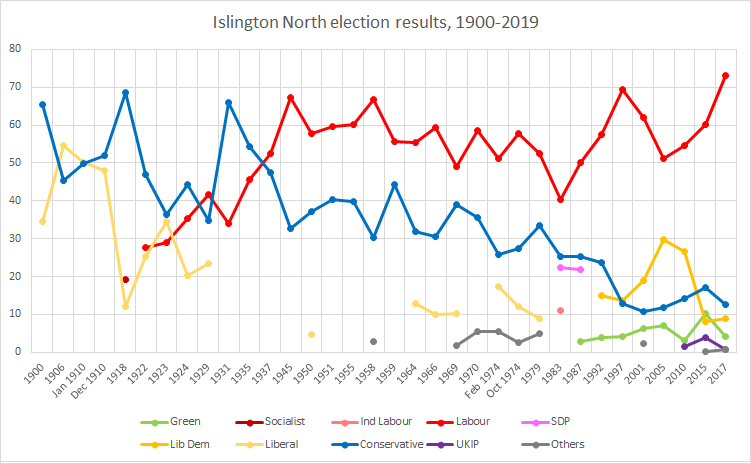
| Elections: | 2010s | 2000s | 1990s | 1980s | 1970s | 1960s | 1950s | 1940s | 1930s | 1920s | 1910s |
Elections in the 2010s
| Party | Candidate | Votes | % | ± | |
|---|---|---|---|---|---|
| Labour | Jeremy Corbyn | 34,603 | 64.3 | −8.7 | |
| Liberal Democrats | Nick Wakeling | 8,415 | 15.6 | +6.6 | |
| Conservative | James Clark | 5,483 | 10.2 | −2.3 | |
| Green | Caroline Russell | 4,326 | 8.0 | +3.9 | |
| Brexit Party | Yosef David | 742 | 1.4 | New | |
| Monster Raving Loony | Nick The Incredible Flying Brick | 236 | 0.4 | +0.2 | |
| Majority | 26,188 | 48.7 | −11.8 | ||
| Turnout | 53,805 | 71.6 | −1.8 | ||
| Registered electors | 75,162 | ||||
| Labour hold | Swing | −7.7 | |||
| Party | Candidate | Votes | % | ± | |
|---|---|---|---|---|---|
| Labour | Jeremy Corbyn | 40,086 | 73.0 | +12.8 | |
| Conservative | James Clark | 6,871 | 12.5 | −4.7 | |
| Liberal Democrats | Keith Angus | 4,946 | 9.0 | +0.9 | |
| Green | Caroline Russell | 2,229 | 4.1 | −6.1 | |
| UKIP | Keith Fraser | 413 | 0.8 | −3.2 | |
| Independent | Michael Foster | 208 | 0.4 | New | |
| Monster Raving Loony | Knigel Knapp | 106 | 0.2 | New | |
| Independent | Susanne Cameron-Blackie | 41 | 0.1 | New | |
| Socialist (GB) | Bill Martin | 21 | 0.1 | −0.2 | |
| Communist League | Andres Mendoza | 7 | 0.03 | New | |
| Majority | 33,215 | 60.5 | +17.5 | ||
| Turnout | 54,515 | 73.4 | +6.3 | ||
| Registered electors | 74,831 | ||||
| Labour hold | Swing | +8.7 | |||
| Party | Candidate | Votes | % | ± | |
|---|---|---|---|---|---|
| Labour | Jeremy Corbyn | 29,659 | 60.2 | +5.7 | |
| Conservative | Alex Burghart | 8,465 | 17.2 | +3.0 | |
| Green | Caroline Russell | 5,043 | 10.2 | +7.2 | |
| Liberal Democrats | Julian Gregory | 3,984 | 8.1 | −18.6 | |
| UKIP | Greg Clough | 1,971 | 4.0 | +2.4 | |
| Socialist (GB) | Bill Martin | 112 | 0.2 | New | |
| Majority | 21,194 | 43.0 | +15.2 | ||
| Turnout | 49,234 | 67.1 | +1.7 | ||
| Registered electors | 73,326 | ||||
| Labour hold | Swing | +1.4 | |||
| Party | Candidate | Votes | % | ± | |
|---|---|---|---|---|---|
| Labour | Jeremy Corbyn | 24,276 | 54.5 | +3.3 | |
| Liberal Democrats | Rhodri Jamieson-Ball | 11,875 | 26.7 | −3.2 | |
| Conservative | Adrian Berrill-Cox | 6,339 | 14.2 | +2.3 | |
| Green | Emma Dixon | 1,348 | 3.0 | −4.1 | |
| UKIP | Dominic Lennon | 716 | 1.6 | New | |
| Majority | 12,401 | 27.8 | +6.5 | ||
| Turnout | 44,554 | 65.4 | +11.5 | ||
| Registered electors | 68,119 | ||||
| Labour hold | Swing | +3.3 | |||
Elections in the 2000s
| Party | Candidate | Votes | % | ± | |
|---|---|---|---|---|---|
| Labour | Jeremy Corbyn | 16,118 | 51.2 | −10.7 | |
| Liberal Democrats | Laura Willoughby | 9,402 | 29.9 | +10.9 | |
| Conservative | Nicola Talbot | 3,740 | 11.9 | +1.1 | |
| Green | Jon Nott | 2,234 | 7.1 | +0.9 | |
| Majority | 6,716 | 21.3 | −21.6 | ||
| Turnout | 31,494 | 53.9 | +5.1 | ||
| Registered electors | 58,428 | ||||
| Labour hold | Swing | −10.8 | |||
| Party | Candidate | Votes | % | ± | |
|---|---|---|---|---|---|
| Labour | Jeremy Corbyn | 18,699 | 61.9 | −7.4 | |
| Liberal Democrats | Laura Willoughby | 5,741 | 19.0 | +5.4 | |
| Conservative | Neil Rands | 3,249 | 10.8 | −2.1 | |
| Green | Christopher Ashby | 1,876 | 6.2 | +2.0 | |
| Socialist Labour | Stephen Cook | 512 | 1.7 | New | |
| Reform 2000 Party | Emine Hassan | 139 | 0.5 | New | |
| Majority | 12,958 | 42.9 | −12.7 | ||
| Turnout | 30,216 | 48.8 | −13.7 | ||
| Registered electors | 61,970 | ||||
| Labour hold | Swing | −6.4 | |||
Elections in the 1990s
| Party | Candidate | Votes | % | ± | |
|---|---|---|---|---|---|
| Labour | Jeremy Corbyn | 24,834 | 69.3 | +11.9 | |
| Liberal Democrats | James Kempton | 4,879 | 13.6 | −1.5 | |
| Conservative | Simon Fawthrop | 4,631 | 12.9 | −10.8 | |
| Green | Christopher Ashby | 1,516 | 4.2 | +0.4 | |
| Majority | 19,955 | 55.6 | +21.9 | ||
| Turnout | 35,860 | 62.5 | −4.1 | ||
| Registered electors | 57,385 | ||||
| Labour hold | Swing | +6.7 | |||
| Party | Candidate | Votes | % | ± | |
|---|---|---|---|---|---|
| Labour | Jeremy Corbyn | 21,742 | 57.4 | +7.4 | |
| Conservative | Lurline Champagnie | 8,958 | 23.7 | −1.6 | |
| Liberal Democrats | Sarah Ludford | 5,732 | 15.1 | −6.7 | |
| Green | Christopher Ashby | 1,420 | 3.8 | +0.9 | |
| Majority | 12,784 | 33.7 | +9.0 | ||
| Turnout | 37,852 | 66.6 | +0.1 | ||
| Registered electors | 56,270 | ||||
| Labour hold | Swing | ||||
Elections in the 1980s
| Party | Candidate | Votes | % | ± | |
|---|---|---|---|---|---|
| Labour | Jeremy Corbyn | 19,577 | 50.0 | +9.6 | |
| Conservative | Ernest Noad | 9,920 | 25.3 | ±0.0 | |
| SDP | Alan Whelan | 8,560 | 21.8 | −0.6 | |
| Green | Christopher Ashby | 1,131 | 2.9 | New | |
| Majority | 9,657 | 24.7 | +9.6 | ||
| Turnout | 38,488 | 66.5 | ±0.0 | ||
| Registered electors | 58,917 | ||||
| Labour hold | Swing | ||||
| Party | Candidate | Votes | % | ± | |
|---|---|---|---|---|---|
| Labour | Jeremy Corbyn | 14,951 | 40.4 | −12.2 | |
| Conservative | David A. Coleman | 9,344 | 25.3 | −8.3 | |
| SDP | John Grant | 8,268 | 22.4 | +13.5 | |
| Independent Labour | Michael O'Halloran | 4,091 | 11.1 | New | |
| BNP | L. A. D. Bearsford-Walker | 176 | 0.5 | New | |
| Independent | Roy A. J. Lincoln | 134 | 0.4 | New | |
| Majority | 5,607 | 15.1 | -3.9 | ||
| Turnout | 36,964 | 66.5 | +5.3 | ||
| Registered electors | 59,984 | ||||
| Labour hold | Swing | ||||
Elections in the 1970s
| Party | Candidate | Votes | % | ± | |
|---|---|---|---|---|---|
| Labour | Michael O'Halloran | 12,317 | 52.6 | −5.3 | |
| Conservative | N. Kerr | 7,861 | 33.6 | +6.1 | |
| Liberal | K. Clarke | 2,079 | 8.9 | −3.3 | |
| National Front | S. Hook | 501 | 2.1 | New | |
| Socialist Unity | M. Simpson | 438 | 1.9 | New | |
| Workers Revolutionary | R. McCullogh | 217 | 0.9 | New | |
| Majority | 4,456 | 19.0 | -11.4 | ||
| Turnout | 23,413 | 61.2 | +7.0 | ||
| Registered electors | 38,253 | ||||
| Labour hold | Swing | ||||
| Party | Candidate | Votes | % | ± | |
|---|---|---|---|---|---|
| Labour | Michael O'Halloran | 12,973 | 57.9 | +6.6 | |
| Conservative | Charles Wellesley | 6,155 | 27.5 | +1.7 | |
| Liberal | M. Davenport | 2,736 | 12.2 | −5.1 | |
| Labour and Democrat | D. Fallon | 558 | 2.5 | +0.3 | |
| Majority | 6,818 | 30.4 | +4.9 | ||
| Turnout | 22,422 | 54.2 | −8.9 | ||
| Registered electors | 41,390 | ||||
| Labour hold | Swing | ||||
| Party | Candidate | Votes | % | ± | |
|---|---|---|---|---|---|
| Labour | Michael O'Halloran | 13,332 | 51.3 | −7.4 | |
| Conservative | Mark Wolfson | 6,704 | 25.8 | −9.8 | |
| Liberal | M. Davenport | 4,503 | 17.3 | New | |
| National Front | J. Score | 871 | 3.4 | −2.2 | |
| Labour and Democrat | D. Fallon | 570 | 2.2 | New | |
| Majority | 6,628 | 25.5 | +2.2 | ||
| Turnout | 25,980 | 63.1 | +14.1 | ||
| Registered electors | 41,185 | ||||
| Labour hold | Swing | ||||
| Party | Candidate | Votes | % | ± | |
|---|---|---|---|---|---|
| Labour | Michael O'Halloran | 13,010 | 58.7 | -0.8 | |
| Conservative | Andrew Pearce | 7,862 | 35.6 | +4.9 | |
| National Front | Brian Green | 1,232 | 5.6 | New | |
| Majority | 5,148 | 23.3 | -5.5 | ||
| Turnout | 22,104 | 49.0 | -5.2 | ||
| Registered electors | 45,083 | ||||
| Labour hold | Swing | ||||
Elections in the 1960s
| Party | Candidate | Votes | % | ± | |
|---|---|---|---|---|---|
| Labour | Michael O'Halloran | 7,288 | 49.2 | −10.2 | |
| Conservative | Andrew Pearce | 5,754 | 38.9 | +8.2 | |
| Liberal | Eric G. Thwaites | 1,514 | 10.2 | +0.4 | |
| Independent Socialist | Austin Williams | 245 | 1.7 | New | |
| Majority | 1,534 | 10.4 | -18.4 | ||
| Turnout | 14,801 | 32.8 | -21.4 | ||
| Registered electors | 45,077 | ||||
| Labour hold | Swing | −9.2 | |||
| Party | Candidate | Votes | % | ± | |
|---|---|---|---|---|---|
| Labour | Gerry Reynolds | 16,188 | 59.46 | +4.15 | |
| Conservative | Michael Morris | 8,357 | 30.69 | -1.06 | |
| Liberal | Eric G. Thwaites | 2,682 | 9.85 | -3.10 | |
| Majority | 7,831 | 28.76 | +5.20 | ||
| Turnout | 27,227 | 54.23 | -0.47 | ||
| Registered electors | 50,203 | ||||
| Labour hold | Swing | ||||
| Party | Candidate | Votes | % | ± | |
|---|---|---|---|---|---|
| Labour | Gerry Reynolds | 15,525 | 55.31 | -0.49 | |
| Conservative | Victor Lyon | 8,912 | 31.75 | -12.45 | |
| Liberal | Eric G. Thwaites | 3,634 | 12.95 | New | |
| Majority | 6,613 | 23.56 | +11.96 | ||
| Turnout | 28,071 | 54.70 | -7.30 | ||
| Registered electors | 51,315 | ||||
| Labour hold | Swing | ||||
Elections in the 1950s
| Party | Candidate | Votes | % | ± | |
|---|---|---|---|---|---|
| Labour | Gerry Reynolds | 18,718 | 55.8 | −4.5 | |
| Conservative | Ronald Bartle | 14,820 | 44.2 | +4.5 | |
| Majority | 3,898 | 11.6 | −9.1 | ||
| Turnout | 33,538 | 62.0 | -2.7 | ||
| Registered electors | 54,120 | ||||
| Labour hold | Swing | −12.5 | |||
| Party | Candidate | Votes | % | ± | |
|---|---|---|---|---|---|
| Labour | Gerry Reynolds | 13,159 | 66.8 | +6.5 | |
| Conservative | Ronald Bartle | 5,968 | 30.3 | −9.4 | |
| Ind. Labour Party | Jim McKie | 576 | 2.9 | New | |
| Majority | 7,461 | 37.9 | +17.2 | ||
| Turnout | 19,703 | 35.6 | -29.1 | ||
| Registered electors | 54,576 | ||||
| Labour hold | Swing | +7.9 | |||
| Party | Candidate | Votes | % | ± | |
|---|---|---|---|---|---|
| Labour | Wilfred Fienburgh | 22,100 | 60.3 | +0.7 | |
| Conservative | Euan Mackinnon | 14,522 | 39.7 | −0.7 | |
| Majority | 7,578 | 20.7 | +1.4 | ||
| Turnout | 36,622 | 64.7 | −13.1 | ||
| Registered electors | 56,574 | ||||
| Labour hold | Swing | +0.7 | |||
| Party | Candidate | Votes | % | ± | |
|---|---|---|---|---|---|
| Labour | Wilfred Fienburgh | 27,406 | 59.6 | +1.7 | |
| Conservative | Graham Page | 18,541 | 40.4 | +3.2 | |
| Majority | 8,865 | 19.3 | −1.4 | ||
| Turnout | 45,947 | 77.8 | +1.1 | ||
| Registered electors | 59,039 | ||||
| Labour hold | Swing | −0.8 | |||
| Party | Candidate | Votes | % | ± | |
|---|---|---|---|---|---|
| Labour | Moelwyn Hughes | 26,354 | 57.9 | −9.5 | |
| Conservative | Graham Page | 16,935 | 37.2 | +4.6 | |
| Liberal | Robert Eric Burns | 2,189 | 4.8 | New | |
| Majority | 9,419 | 20.7 | −14.1 | ||
| Turnout | 45,478 | 76.7 | +9.5 | ||
| Registered electors | 59,086 | ||||
| Labour hold | Swing | −7.1 | |||
Elections in the 1940s
| Party | Candidate | Votes | % | ± | |
|---|---|---|---|---|---|
| Labour | Leslie Haden-Guest | 23,234 | 67.4 | +14.9 | |
| Conservative | Charles Rhys | 11,240 | 32.6 | −14.9 | |
| Majority | 11,994 | 34.8 | +29.8 | ||
| Turnout | 23,236 | 67.2 | +26.8 | ||
| Registered electors | 51,324 | ||||
| Labour gain from Conservative | Swing | +14.9 | |||
Elections in the 1930s
| Party | Candidate | Votes | % | ± | |
|---|---|---|---|---|---|
| Labour | Leslie Haden-Guest | 13,523 | 52.5 | +6.9 | |
| Conservative | Wilfrid Sugden | 12,227 | 47.5 | −6.9 | |
| Majority | 1,296 | 5.0 | -3.9 | ||
| Turnout | 27,750 | 40.4 | -19.3 | ||
| Registered electors | 63,747 | ||||
| Labour gain from Conservative | Swing | 6.9 | |||
| Party | Candidate | Votes | % | ± | |
|---|---|---|---|---|---|
| Conservative | Albert Goodman | 20,744 | 54.44 | -11.63 | |
| Labour | Robert Young | 17,359 | 45.56 | +11.63 | |
| Majority | 3,385 | 8.88 | -23.27 | ||
| Turnout | 38,103 | 59.69 | -8.65 | ||
| Registered electors | 63,835 | ||||
| Conservative hold | Swing | ||||
| Party | Candidate | Votes | % | ± | |
|---|---|---|---|---|---|
| Conservative | Albert Goodman | 28,790 | 66.07 | +31.27 | |
| Labour | Robert Young | 14,783 | 33.93 | -8.87 | |
| Majority | 14,007 | 32.15 | +25.15 | ||
| Turnout | 43,573 | 66.54 | -1.46 | ||
| Registered electors | 65,486 | ||||
| Conservative gain from Labour | Swing | ||||
Elections in the 1920s
| Party | Candidate | Votes | % | ± | |
|---|---|---|---|---|---|
| Labour | Robert Young | 18,272 | 41.8 | +6.5 | |
| Unionist | Gordon Touche | 15,207 | 34.8 | -9.6 | |
| Liberal | Domini Crosfield | 10,210 | 23.4 | +3.1 | |
| Majority | 3,065 | 7.0 | N/A | ||
| Turnout | 43,689 | 68.0 | -4.2 | ||
| Registered electors | 64,241 | ||||
| Labour gain from Unionist | Swing | +8.1 | |||
| Party | Candidate | Votes | % | ± | |
|---|---|---|---|---|---|
| Unionist | Henry Cowan | 15,562 | 44.4 | +7.9 | |
| Labour | Ewart Culpin | 12,376 | 35.3 | +6.4 | |
| Liberal | Norman Thomas Carr Sargant | 7,136 | 20.3 | -14.3 | |
| Majority | 3,186 | 9.1 | +7.2 | ||
| Turnout | 35,074 | 72.2 | +10.6 | ||
| Registered electors | 48,573 | ||||
| Unionist hold | Swing | +0.8 | |||

| Party | Candidate | Votes | % | ± | |
|---|---|---|---|---|---|
| Unionist | Henry Cowan | 10,802 | 36.5 | -10.5 | |
| Liberal | Norman Thomas Carr Sargant | 10,219 | 34.6 | +9.4 | |
| Labour | George Bennett | 8,556 | 28.9 | +1.1 | |
| Majority | 583 | 1.9 | -17.3 | ||
| Turnout | 29,577 | 61.6 | +0.5 | ||
| Registered electors | 48,002 | ||||
| Unionist hold | Swing | -10.0 | |||
| Party | Candidate | Votes | % | ± | |
|---|---|---|---|---|---|
| Unionist | Newton Moore | 13,520 | 47.0 | -21.5 | |
| Labour | Edith Picton-Turbervill | 7,993 | 27.8 | New | |
| Liberal | Norman Thomas Carr Sargant | 7,256 | 25.2 | +13.0 | |
| Majority | 5,527 | 19.2 | -30.0 | ||
| Turnout | 28,769 | 61.1 | +11.5 | ||
| Registered electors | 47,059 | ||||
| Unionist hold | Swing | -17.3 | |||
Elections in the 1910s
.jpeg)
| Party | Candidate | Votes | % | ± | |
|---|---|---|---|---|---|
| C | Unionist | Newton Moore | 14,183 | 68.5 | +16.6 |
| British Socialist Party | *John Arnall | 4,000 | 19.3 | New | |
| Liberal | Norman Thomas Carr Sargant | 2,529 | 12.2 | -35.9 | |
| Majority | 10,183 | 49.2 | +45.4 | ||
| Turnout | 20,712 | 49.6 | −32.8 | ||
| Registered electors | 41,769 | ||||
| Unionist hold | Swing | +26.3 | |||
| C indicates candidate endorsed by the coalition government. | |||||
* Craig lists Arnall as an Independent Labour candidate.
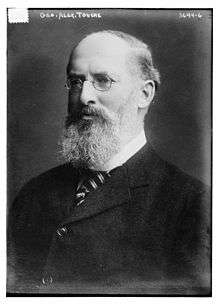
| Party | Candidate | Votes | % | ± | |
|---|---|---|---|---|---|
| Conservative | George Touche | 5,428 | 51.9 | +2.0 | |
| Liberal | David Waterlow | 5,022 | 48.1 | -2.0 | |
| Majority | 406 | 3.8 | N/A | ||
| Turnout | 10,450 | 82.4 | -4.8 | ||
| Registered electors | 12,677 | ||||
| Conservative gain from Liberal | Swing | +2.0 | |||
| Party | Candidate | Votes | % | ± | |
|---|---|---|---|---|---|
| Liberal | David Waterlow | 5,543 | 50.1 | -4.4 | |
| Conservative | George Touche | 5,512 | 49.9 | +4.4 | |
| Majority | 31 | 0.2 | -8.8 | ||
| Turnout | 11,055 | 87.2 | +6.9 | ||
| Registered electors | 12,677 | ||||
| Liberal hold | Swing | -4.4 | |||
Elections in the 1900s
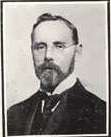
| Party | Candidate | Votes | % | ± | |
|---|---|---|---|---|---|
| Liberal | David Waterlow | 5,284 | 54.5 | +20.0 | |
| Conservative | George Trout Bartley | 4,418 | 45.5 | -20.0 | |
| Majority | 866 | 9.0 | N/A | ||
| Turnout | 9,702 | 80.3 | +18.0 | ||
| Registered electors | 12,075 | ||||
| Liberal gain from Conservative | Swing | +20.0 | |||
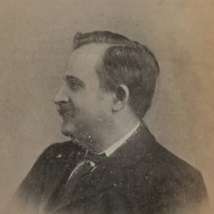
| Party | Candidate | Votes | % | ± | |
|---|---|---|---|---|---|
| Conservative | George Trout Bartley | 4,881 | 65.5 | +7.3 | |
| Liberal | Edmund Charles Rawlings | 2,567 | 34.5 | -7.3 | |
| Majority | 2,314 | 31.0 | +14.6 | ||
| Turnout | 7,448 | 62.3 | -11.2 | ||
| Registered electors | 11,964 | ||||
| Conservative hold | Swing | +7.3 | |||
Elections in the 1890s
| Party | Candidate | Votes | % | ± | |
|---|---|---|---|---|---|
| Conservative | George Trout Bartley | 4,626 | 58.2 | +3.2 | |
| Liberal | Thomas Bateman Napier | 3,317 | 41.8 | -3.2 | |
| Majority | 1,309 | 16.4 | +6.4 | ||
| Turnout | 7,943 | 73.5 | -1.6 | ||
| Registered electors | 10,803 | ||||
| Conservative hold | Swing | +3.2 | |||
| Party | Candidate | Votes | % | ± | |
|---|---|---|---|---|---|
| Conservative | George Trout Bartley | 4,456 | 55.0 | -8.6 | |
| Liberal | James Hill[33] | 3,646 | 45.0 | +8.6 | |
| Majority | 810 | 10.0 | -17.2 | ||
| Turnout | 8,102 | 75.1 | +5.2 | ||
| Registered electors | 10,782 | ||||
| Conservative hold | Swing | -8.6 | |||
Elections in the 1880s
| Party | Candidate | Votes | % | ± | |
|---|---|---|---|---|---|
| Conservative | George Trout Bartley | 3,456 | 63.6 | +9.2 | |
| Liberal | Peter Clayden | 1,976 | 36.4 | -9.2 | |
| Majority | 1,480 | 27.2 | +18.4 | ||
| Turnout | 5,432 | 69.9 | -13.9 | ||
| Registered electors | 7,774 | ||||
| Conservative hold | Swing | +9.2 | |||
| Party | Candidate | Votes | % | ± | |
|---|---|---|---|---|---|
| Conservative | George Trout Bartley | 3,545 | 54.4 | N/A | |
| Liberal | Samuel Danks Waddy | 2,972 | 45.6 | N/A | |
| Majority | 573 | 8.8 | N/A | ||
| Turnout | 6,517 | 83.8 | N/A | ||
| Registered electors | 7,774 | ||||
| Conservative win (new seat) | |||||
Further information
A short film was made about the 1969 by-election. This highlighted the importance of the local Irish community, the poor local housing conditions (the opening line talks of "a crowded, crumbling constituency") and the relatively low turn-outs at previous elections. The film is now available through British Pathé Archive.[34]
Michael O'Halloran, elected Labour MP for Islington North in 1969, was the subject of an investigation in the early-1970s by The Sunday Times newspaper. They highlighted his background with a local building company and the local Irish community and queried the tactics of his supporters during his selection as candidate.
O'Halloran defected to the SDP in September 1981, as did both of the other Islington MPs. However the Boundary Commission cut the number of constituencies in Islington from three to two. O'Halloran sought selection as the SDP candidate for the revised Islington North constituency but the local SDP association selected John Grant, then-SDP (elected as Labour) MP for Islington Central, as their official candidate. In February 1983, O'Halloran resigned his membership of the SDP and sat in Parliament as an "Independent Labour" member, supporting the Parliamentary Labour Party. Despite this, he failed to regain the Labour Party nomination for the 1983 general election and he was defeated by the new Labour candidate, Jeremy Corbyn, and finished in fourth place with 11.1% of the vote.
Corbyn defeated Paul Boateng for the Labour Party selection. Boateng subsequently became the first Black Cabinet Minister in the UK.
See also
Notes and references
- Notes
- As with all constituencies, the constituency elects one Member of Parliament (MP) by the first past the post system of election at least every five years.
- References
- "Electorate Figures – Boundary Commission for England". 2011 Electorate Figures. Boundary Commission for England. 4 March 2011. Archived from the original on 6 November 2010. Retrieved 13 March 2011.
- List of Labour MPs elected in 2015 by % majority UK Political.info. Retrieved 2017-01-29.
- "Revised estimates of leave vote in Westminster constituencies". Retrieved 26 October 2016.
- Redistribution Of Seats Act, 1885. Sixth Schedule. Divisions Of Boroughs. Number, Names, Contents, And Boundaries Of Divisions.
- Youngs Jr., Frederic A. (1979). Guide to the Local Administrative Units of England, Vol.I: Southern England. London: Royal Historical Society. pp. 743, 746, 749. ISBN 0-901050-67-9.
- Representation Of The People Act 1918. Ninth Schedule. Redistribution Of Seats.
- Representation Of The People Act 1948, First Schedule. Parliamentary Constituencies.
- The Parliamentary Constituencies (England) Order 1970 (S.I. 1970/1674).
- The Parliamentary Constituencies (England) Order 1983 (S.I. 1983/417).
- "The Parliamentary Constituencies (England) Order 1995 (S.I. 1995/1626)". legislation.gov.uk. The National Archives (United Kingdom). Retrieved 27 May 2013.
- "The Parliamentary Constituencies (England) Order 2007 (S.I. 2007/1681)". legislation.gov.uk. The National Archives (United Kingdom). Retrieved 27 May 2013.
- Parliamentary constituencies, UK Parliament; Accessed 12 August 2015.
- "Fifth Periodical Report" (PDF).
- Leigh Rayment's Historical List of MPs – Constituencies beginning with "T" (part 1)
- "General Election 2019 candidates". London Borough of Islington. Retrieved 14 November 2019.
- "Election results". London Borough of Islington. Retrieved 7 May 2018.
- http://researchbriefings.files.parliament.uk/documents/CBP-7979/CBP-7979.pdf
- "Election Data 2015". Electoral Calculus. Archived from the original on 17 October 2015. Retrieved 17 October 2015.
- "Islington Council". Archived from the original on March 4, 2016.
- General Election – Campaign News Archived 2015-01-20 at the Wayback Machine Socialist Party of Great Britain, 15 January 2015.
- "Election Data 2010". Electoral Calculus. Archived from the original on 26 July 2013. Retrieved 17 October 2015.
- "Islington Council" (PDF). Archived from the original (PDF) on March 3, 2012.
- "Election Data 2005". Electoral Calculus. Archived from the original on 15 October 2011. Retrieved 18 October 2015.
- "Election Data 2001". Electoral Calculus. Archived from the original on 15 October 2011. Retrieved 18 October 2015.
- "Election Data 1997". Electoral Calculus. Archived from the original on 15 October 2011. Retrieved 18 October 2015.
- "Election Data 1992". Electoral Calculus. Archived from the original on 15 October 2011. Retrieved 18 October 2015.
- "Election Data 1987". Electoral Calculus. Archived from the original on 15 October 2011. Retrieved 18 October 2015.
- "Election Data 1983". Electoral Calculus. Archived from the original on 15 October 2011. Retrieved 18 October 2015.
- "1969 By Election Results". British Elections Ephemera Archive. Archived from the original on 2012-03-14. Retrieved 2015-08-27.
- "1958 By Election Results". Archived from the original on 2012-06-25. Retrieved 2015-08-15.
- British Parliamentary Election Results 1918–1949, F. W. S. Craig.
- British Parliamentary Election Results 1885–1918, F. W. S. Craig.
- "Islington". London Standard. 6 July 1892. p. 5. Retrieved 11 November 2017.
- "North Islington Elections (1969)" – via www.youtube.com.
External links
- Politics Resources (election results from 1922 onwards)
- Electoral Calculus (election results from 1955 onwards)
Bibliography
- Iain Dale, ed. (2003). The Times House of Commons 1929, 1931, 1935. Politico's (reprint). ISBN 1-84275-033-X.
- The Times House of Commons 1945. The Times. 1945.
- The Times House of Commons 1950. The Times. 1950.
- The Times House of Commons 1955. The Times. 1955.
- Craig, F. W. S. (1983) [1969]. British parliamentary election results 1918–1949 (3rd ed.). Chichester: Parliamentary Research Services. ISBN 0-900178-06-X.
| Parliament of the United Kingdom | ||
|---|---|---|
| Preceded by Camberwell and Peckham |
Constituency represented by the Leader of the Opposition 2015–2020 |
Succeeded by Holborn and St Pancras |
